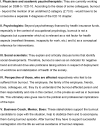The Burnout Phenomenon: A Résumé After More Than 15,000 Scientific Publications
- PMID: 33424648
- PMCID: PMC7793987
- DOI: 10.3389/fpsyt.2020.519237
The Burnout Phenomenon: A Résumé After More Than 15,000 Scientific Publications
Abstract
The "burnout" phenomenon, supposedly caused by work related stress, is a challenge for academic psychiatry both conceptually and professionally. Since the first description of burnout in 1974 until today, more than 140 definitions have been suggested. Burnout-symptomatology's main characteristic, the experience of exhaustion, is unspecific. Different development-models of burnout were proposed, assumed to depict a quasi-natural process. These could not be confirmed empirically. An expert consensus on the diagnostic criteria and the conceptual location, whether as an independent disorder or as a risk, could not be agreed on. Nevertheless, the phenomenon of burnout in the ICD-11 is considered to be categorized as a work-related disorder. Psychiatric research on the burnout-phenomenon ignores problems of definition resulting from different perspectives: It may meet societal expectations, but does not fulfill scientific criteria, and therefore is not suitable to establish an objective diagnosis and treatment. Parallel detection of ICD/DSM diagnoses from an expert perspective and subjective perturbation models are considered appropriate.
Keywords: burnout; concepts of mental illness; depression; scientific conceptualization of psychic phenomena; stress; subjective disease models; work-related disorders.
Copyright © 2020 Hillert, Albrecht and Voderholzer.
Conflict of interest statement
The authors declare that the research was conducted in the absence of any commercial or financial relationships that could be construed as a potential conflict of interest. The handling editor declared a past collaboration with one of the authors UV.
Figures
References
-
- Freudenberger HJ. Staff burn-out. J Soc Issues. (1974) 30:159–65.
-
- Schaufeli WB, Buunk BP. Burn-out: an overview of 25 years of research theorizing. In: Marc Schabracq J, Jacques Winnubst AM, Cooper CL, editrs. (Hrsg.): The Handbook of Work and Health Psychology. 2. Auflage. John Wiley & Sons: Chichester; (2003). p. 382–425. 10.1002/0470013400.ch19 - DOI
-
- Hillert A, Marwitz M. Die Burn-out-Epidemie. Oder: Brennt Die Leistungsgesellschaft aus? München: Beck; (2006).
-
- Burisch M. Das Burn-Out-Syndrom. Theorie der Inneren Erschöpfung (5. Aufl.). Heidelberg: Springer; (2014). p. 14–78. 10.1007/978-3-642-36255-2 - DOI
-
- Maslach C, Jackson SE, Leiter MP. Maslach Burn-Out Inventory Manual, 3rd Edn Palo Alto: Consulting Psychologists Press; (1996).
LinkOut - more resources
Full Text Sources






